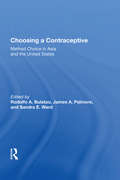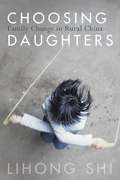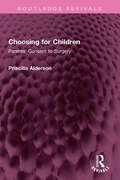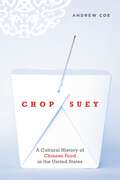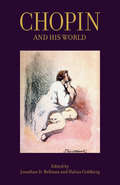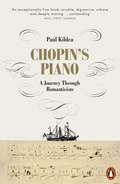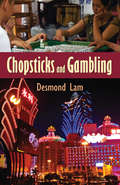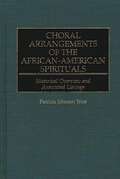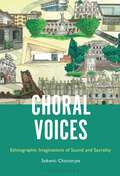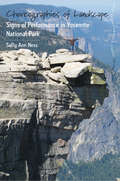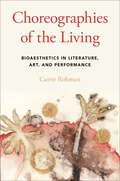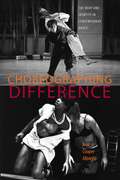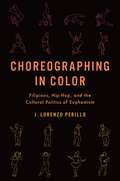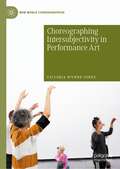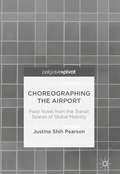- Table View
- List View
Choosing A Contraceptive: Method Choice In Asia And The United States
by Rodolfo A. BulataoThis book presents evidence from investigations of contraceptive method choice in a variety of countries, focusing on Asia and the United States. Included are discussions of psychosocial and economic approaches to understanding method choice and descriptive and statistical analyses of choices.
Choosing A Contraceptive: Method Choice In Asia And The United States
by Rodolfo A. Bulatao James A. Palmore Sandra E. WardThis book presents evidence from investigations of contraceptive method choice in a variety of countries, focusing on Asia and the United States. Included are discussions of psychosocial and economic approaches to understanding method choice and descriptive and statistical analyses of choices.
Choosing Daughters: Family Change in Rural China
by Lihong ShiChina's patrilineal and patriarchal tradition has encouraged a long-standing preference for male heirs within families. Coupled with China's birth-planning policy, this has led to a severe gender imbalance. But a counterpattern is emerging in rural China where a noticeable proportion of young couples have willingly accepted having a single daughter. They are doing so even as birth-planning policies are being relaxed and having a second child, and the opportunity of having a son, is a new possibility. Choosing Daughters explores this critical, yet largely overlooked, reproductive pattern emerging in China's demographic landscape. Lihong Shi delves into the social, economic, and cultural forces behind the complex decision-making process of these couples to unravel their life goals and childrearing aspirations, the changing family dynamics and gender relations, and the intimate parent–daughter ties that have engendered this drastic transformation of reproductive choice. She reveals a leading-edge social force that fosters China's recent fertility decline, namely pursuit of a modern family and successful childrearing achieved through having a small family. Through this discussion, Shi refutes the conventional understanding of a universal preference for sons and discrimination against daughters in China and counters claims of continuing resistance against China's population control program.
Choosing for Children: Parents' Consent to Surgery (Routledge Revivals)
by Priscilla AldersonOne mother described part of the complications of consenting to her one-week-old child’s high-risk heart surgery. ‘I can’t imagine her being any more precious to me than she is now. I can hardly bear feeling so close to her as it is…I can’t wait until I see her again. It’s worse than being in love.’ Can emotional parents be rational enough to give informed proxy consent? Research observations and interviews with many parents and practitioners in the wards, clinics and medical meetings in two London hospitals show how parents’ moral emotions of fear and hope are central to their informed decision-making and voluntary consent. This record from the 1980s offers useful historical comparisons with today’s paediatric cardiac services in both the remarkable progress over nearly 40 years and the continuing concerns.
Choosing for Children: Parents' Consent to Surgery (Routledge Revivals)
by Priscilla AldersonOne mother described part of the complications of consenting to her one-week-old child’s high-risk heart surgery. ‘I can’t imagine her being any more precious to me than she is now. I can hardly bear feeling so close to her as it is…I can’t wait until I see her again. It’s worse than being in love.’ Can emotional parents be rational enough to give informed proxy consent? Research observations and interviews with many parents and practitioners in the wards, clinics and medical meetings in two London hospitals show how parents’ moral emotions of fear and hope are central to their informed decision-making and voluntary consent. This record from the 1980s offers useful historical comparisons with today’s paediatric cardiac services in both the remarkable progress over nearly 40 years and the continuing concerns.
Choosing Our Future: A Practical Politics of the Environment (Routledge Revivals)
by Ann TaylorFirst Published in 1992, Choosing Our Future presents a personal but highly rigorous account of the environmental problems facing us and of the ways in which they can be tackled. Ann Taylor's approach centres on the traditional values of democratic socialism, establishing their inherent compatibility with modern concerns of sustainable economic development and environmental protection. She argues that people and planet are interdependent and that ensuring a balance between the needs of both is the historic role of the Labour Party. Lucid and topical, this book will appeal to anyone who is interested in realistic, hard- headed solutions to environmental problems. It will be of interest to general readers and to members of the Labour movement, environmentalists and professionals in environmental management and regulation. It will also be useful to students of politics and development.
Choosing Our Future: A Practical Politics of the Environment (Routledge Revivals)
by Ann TaylorFirst Published in 1992, Choosing Our Future presents a personal but highly rigorous account of the environmental problems facing us and of the ways in which they can be tackled. Ann Taylor's approach centres on the traditional values of democratic socialism, establishing their inherent compatibility with modern concerns of sustainable economic development and environmental protection. She argues that people and planet are interdependent and that ensuring a balance between the needs of both is the historic role of the Labour Party. Lucid and topical, this book will appeal to anyone who is interested in realistic, hard- headed solutions to environmental problems. It will be of interest to general readers and to members of the Labour movement, environmentalists and professionals in environmental management and regulation. It will also be useful to students of politics and development.
Chop Suey: A Cultural History of Chinese Food in the United States
by Andrew CoeIn 1784, passengers on the ship Empress of China became the first Americans to land in China, and the first to eat Chinese food. Today there are over 40,000 Chinese restaurants across the United States--by far the most plentiful among all our ethnic eateries. Now, in Chop Suey Andrew Coe provides the authoritative history of the American infatuation with Chinese food, telling its fascinating story for the first time. It's a tale that moves from curiosity to disgust and then desire. From China, Coe's story travels to the American West, where Chinese immigrants drawn by the 1848 Gold Rush struggled against racism and culinary prejudice but still established restaurants and farms and imported an array of Asian ingredients. He traces the Chinese migration to the East Coast, highlighting that crucial moment when New York "Bohemians" discovered Chinese cuisine--and for better or worse, chop suey. Along the way, Coe shows how the peasant food of an obscure part of China came to dominate Chinese-American restaurants; unravels the truth of chop suey's origins; reveals why American Jews fell in love with egg rolls and chow mein; shows how President Nixon's 1972 trip to China opened our palates to a new range of cuisine; and explains why we still can't get dishes like those served in Beijing or Shanghai. The book also explores how American tastes have been shaped by our relationship with the outside world, and how we've relentlessly changed foreign foods to adapt to them our own deep-down conservative culinary preferences. Andrew Coe's Chop Suey: A Cultural History of Chinese Food in the United States is a fascinating tour of America's centuries-long appetite for Chinese food. Always illuminating, often exploding long-held culinary myths, this book opens a new window into defining what is American cuisine.
Chop Suey: A Cultural History of Chinese Food in the United States
by Andrew CoeIn 1784, passengers on the ship Empress of China became the first Americans to land in China, and the first to eat Chinese food. Today there are over 40,000 Chinese restaurants across the United States--by far the most plentiful among all our ethnic eateries. Now, in Chop Suey Andrew Coe provides the authoritative history of the American infatuation with Chinese food, telling its fascinating story for the first time. It's a tale that moves from curiosity to disgust and then desire. From China, Coe's story travels to the American West, where Chinese immigrants drawn by the 1848 Gold Rush struggled against racism and culinary prejudice but still established restaurants and farms and imported an array of Asian ingredients. He traces the Chinese migration to the East Coast, highlighting that crucial moment when New York "Bohemians" discovered Chinese cuisine--and for better or worse, chop suey. Along the way, Coe shows how the peasant food of an obscure part of China came to dominate Chinese-American restaurants; unravels the truth of chop suey's origins; reveals why American Jews fell in love with egg rolls and chow mein; shows how President Nixon's 1972 trip to China opened our palates to a new range of cuisine; and explains why we still can't get dishes like those served in Beijing or Shanghai. The book also explores how American tastes have been shaped by our relationship with the outside world, and how we've relentlessly changed foreign foods to adapt to them our own deep-down conservative culinary preferences. Andrew Coe's Chop Suey: A Cultural History of Chinese Food in the United States is a fascinating tour of America's centuries-long appetite for Chinese food. Always illuminating, often exploding long-held culinary myths, this book opens a new window into defining what is American cuisine.
Chopin and His World
by Jonathan D. Bellman Halina GoldbergA new look at the life, times, and music of Polish composer and piano virtuoso Fryderyk ChopinFryderyk Chopin (1810–49), although the most beloved of piano composers, remains a contradictory figure, an artist of virtually universal appeal who preferred the company of only a few sympathetic friends and listeners. Chopin and His World reexamines Chopin and his music in light of the cultural narratives formed during his lifetime. These include the romanticism of the ailing spirit, tragically singing its death-song as life ebbs; the Polish expatriate, helpless witness to the martyrdom of his beloved homeland, exiled among friendly but uncomprehending strangers; the sorcerer-bard of dream, memory, and Gothic terror; and the pianist's pianist, shunning the appreciative crowds yet composing and improvising idealized operas, scenes, dances, and narratives in the shadow of virtuoso-idol Franz Liszt. The international Chopin scholars gathered here demonstrate the ways in which Chopin responded to and was understood to exemplify these narratives, as an artist of his own time and one who transcended it. This collection also offers recently rediscovered artistic representations of his hands (with analysis), and—for the first time in English—an extended tribute to Chopin published in Poland upon his death and contemporary Polish writings contextualizing Chopin's compositional strategies. The contributors are Jonathan D. Bellman, Leon Botstein, Jean-Jacques Eigeldinger, Halina Goldberg, Jeffrey Kallberg, David Kasunic, Anatole Leikin, Eric McKee, James Parakilas, John Rink, and Sandra P. Rosenblum. Contemporary documents by Karol Kurpiński, Adam Mickiewicz, and Józef Sikorski are included.
Chopin and His World (PDF)
by Jonathan D. Bellman Halina GoldbergA new look at the life, times, and music of Polish composer and piano virtuoso Fryderyk ChopinFryderyk Chopin (1810–49), although the most beloved of piano composers, remains a contradictory figure, an artist of virtually universal appeal who preferred the company of only a few sympathetic friends and listeners. Chopin and His World reexamines Chopin and his music in light of the cultural narratives formed during his lifetime. These include the romanticism of the ailing spirit, tragically singing its death-song as life ebbs; the Polish expatriate, helpless witness to the martyrdom of his beloved homeland, exiled among friendly but uncomprehending strangers; the sorcerer-bard of dream, memory, and Gothic terror; and the pianist's pianist, shunning the appreciative crowds yet composing and improvising idealized operas, scenes, dances, and narratives in the shadow of virtuoso-idol Franz Liszt. The international Chopin scholars gathered here demonstrate the ways in which Chopin responded to and was understood to exemplify these narratives, as an artist of his own time and one who transcended it. This collection also offers recently rediscovered artistic representations of his hands (with analysis), and—for the first time in English—an extended tribute to Chopin published in Poland upon his death and contemporary Polish writings contextualizing Chopin's compositional strategies. The contributors are Jonathan D. Bellman, Leon Botstein, Jean-Jacques Eigeldinger, Halina Goldberg, Jeffrey Kallberg, David Kasunic, Anatole Leikin, Eric McKee, James Parakilas, John Rink, and Sandra P. Rosenblum. Contemporary documents by Karol Kurpiński, Adam Mickiewicz, and Józef Sikorski are included.
Chopin's Piano: A Journey through Romanticism
by Paul KildeaIn November 1838 Frédéric Chopin, George Sand and her two children sailed to Majorca to escape the Parisian winter. They settled in an abandoned monastery at Valldemossa in the mountains above Palma, where Chopin finished what would eventually be recognised as one of the great and revolutionary works of musical Romanticism - his 24 Preludes. There was scarcely a decent piano on the island (these were still early days in the evolution of the modern instrument), so Chopin worked on a small pianino made by a local craftsman, which remained in their monastic cell for seventy years after he and Sand had left.This brilliant and unclassifiable book traces the history of Chopin's 24 Preludes through the instruments on which they were played, the pianists who interpreted them and the traditions they came to represent. Yet it begins and ends with the Majorcan pianino, which during the Second World War assumed an astonishing cultural potency as it became, for the Nazis, a symbol of the man and music they were determined to appropriate as their own.The unexpected hero of the second part of the book is the great keyboard player and musical thinker Wanda Landowska, who rescued the pianino from Valldemossa in 1913, and who would later become one of the most influential musical figures of the twentieth century. Kildea shows how her story - a compelling account based for the first time on her private papers - resonates with Chopin's, while simultaneously distilling part of the cultural and political history of Europe and the United States in the central decades of the century. Kildea's beautifully interwoven narratives, part cultural history and part detective story, take us on an unexpected journey through musical Romanticism and allow us to reflect freshly on the changing meaning of music over time.
Chopsticks and Gambling
by Desmond LamThe Chinese are known throughout the world as avid gamblers with a long history of participation in games of chance. Historians have documented wagering on such games as far back as the early Chinese dynasties. Despite measures by ancient Chinese rulers to contain gambling, it proliferated, and Chinese games have evolved and multiplied since then. Desmond Lam provides a unique look into the little-known world of Chinese gambling from historical, cultural, psychological, and social perspectives.Chinese gamblers regularly patronize casinos in the United States, Canada, and Australia. The recent expansion of gambling in East Asia has attracted much global media attention. Macau, the only place in China where casino gambling is now legal, easily surpasses Las Vegas as the world's largest casino gaming market. Each year, Chinese from mainland China, Hong Kong, and Taiwan account for almost 90 percent of visitors to Macau.The expansion of the Chinese gambling industry has brought about much harm to Chinese communities, despite all of the development it has also stimulated. This book is the first to examine the beliefs, motivations, attitudes, and behaviors of Chinese gamblers, and will be of interest to students of history and sociology, as well as those studying the history and culture of China.
Chopsticks and Gambling
by Desmond LamThe Chinese are known throughout the world as avid gamblers with a long history of participation in games of chance. Historians have documented wagering on such games as far back as the early Chinese dynasties. Despite measures by ancient Chinese rulers to contain gambling, it proliferated, and Chinese games have evolved and multiplied since then. Desmond Lam provides a unique look into the little-known world of Chinese gambling from historical, cultural, psychological, and social perspectives.Chinese gamblers regularly patronize casinos in the United States, Canada, and Australia. The recent expansion of gambling in East Asia has attracted much global media attention. Macau, the only place in China where casino gambling is now legal, easily surpasses Las Vegas as the world's largest casino gaming market. Each year, Chinese from mainland China, Hong Kong, and Taiwan account for almost 90 percent of visitors to Macau.The expansion of the Chinese gambling industry has brought about much harm to Chinese communities, despite all of the development it has also stimulated. This book is the first to examine the beliefs, motivations, attitudes, and behaviors of Chinese gamblers, and will be of interest to students of history and sociology, as well as those studying the history and culture of China.
Choral Arrangements of the African-American Spirituals: Historical Overview and Annotated Listings (Music Reference Collection)
by Patricia J. TriceAlthough the choral arrangements of the African-American spirituals constitute the largest group of folk song arrangements in western literature, they have received little scholarly attention. This book provides the needed historical and stylistic information about the spirituals and the arrangements. It traces the history and cultural roots of the genre through its inception and delineates the African and European characteristics common to the original folk songs and arrangements. Ensembles that have perpetuated the growth of the spiritual arrangements—from Fisk Jubilee Singers of the 1870s through those currently active—are chronicled as well.Musicians, choral directors, and scholars will welcome this first complete text on the African-American spiritual genre. Annotated listings of titles provide information choral directors need to make ensemble-appropriate performance choices. Arrangements indexed by title, arranger, and subject complement the accompanying biographies and repertoire information. Well-organized and thoroughly researched, this text is a valuable addition to music, choral, multicultural, and African-American libraries.
Choral Voices: Ethnographic Imaginations of Sound and Sacrality
by Sebanti ChatterjeeChoral Voices: Ethnographic Imaginations of Sound and Sacrality is about sacred and secular choirs in Goa and Shillong across churches, seminaries, schools, auditoriums, classrooms, reality TV shows, and festivals. Voice and genre emerge as social objects annotated by tradition, nostalgia, and innovation. Piety literally and metaphorically shapes the Christian lifeworld, predominantly those belonging to the Presbyterian and Catholic denominations. Indigeneity structures the political and cultural motifs in the making of the Christian musical traditions. Located at the intersection of Sociology, Anthropology, and Ethnomusicology, the choral voices emplace 'affect' and the visual-aural dispatch. Thus, sonic spectrum holds space for indigenous and global musicality.This ethnographic work will be useful for scholars researching music and sound studies, religious studies, cultural anthropology, and sociology of India.
Choral Voices: Ethnographic Imaginations of Sound and Sacrality
by Sebanti ChatterjeeChoral Voices: Ethnographic Imaginations of Sound and Sacrality is about sacred and secular choirs in Goa and Shillong across churches, seminaries, schools, auditoriums, classrooms, reality TV shows, and festivals. Voice and genre emerge as social objects annotated by tradition, nostalgia, and innovation. Piety literally and metaphorically shapes the Christian lifeworld, predominantly those belonging to the Presbyterian and Catholic denominations. Indigeneity structures the political and cultural motifs in the making of the Christian musical traditions. Located at the intersection of Sociology, Anthropology, and Ethnomusicology, the choral voices emplace 'affect' and the visual-aural dispatch. Thus, sonic spectrum holds space for indigenous and global musicality.This ethnographic work will be useful for scholars researching music and sound studies, religious studies, cultural anthropology, and sociology of India.
Choreographies of Landscape: Signs of Performance in Yosemite National Park (Dance and Performance Studies #8)
by Sally Ann NessAs an international ecotourism destination, Yosemite National Park welcomes millions of climbers, sightseers, and other visitors from around the world annually, all of whom are afforded dramatic experiences of the natural world. This original and cross-disciplinary book offers an ethnographic and performative study of Yosemite visitors in order to understand human connection with and within natural landscapes. By grounding a novel “eco-semiotic” analysis in the lived reality of parkgoers, it forges surprising connections, assembling a collective account that will be of interest to disciplines ranging from performance studies to cultural geography.
Choreographies of the Living: Bioaesthetics in Literature, Art, and Performance
by Carrie RohmanChoreographies of the Living explores the implications of shifting from viewing art as an exclusively human undertaking to recognizing it as an activity that all living creatures enact. Carrie Rohman reveals the aesthetic impulse itself to be profoundly trans-species, and in doing so she revises our received wisdom about the value and functions of artistic capacities. Countering the long history of aesthetic theory in the West--beginning with Plato and Aristotle, and moving up through the recent claims of "neuroaesthetics"--Rohman challenges the likening of aesthetic experience to an exclusively human form of judgment. Turning toward the animal in new frameworks for understanding aesthetic impulses, Rohman emphasizes a deep coincidence of humans' and animals' elaborations of fundamental life forces. Examining a range of literary, visual, dance, and performance works and processes by modernist and contemporary figures such as Isadora Duncan, D. H. Lawrence, Virginia Woolf, and Merce Cunningham, Rohman reconceives the aesthetic itself not as a distinction separating humans from other animals, but rather as a framework connecting embodied beings. Her view challenges our species to acknowledge the shared status of art-making, one of our most hallowed and formerly exceptional activities.
CHOREOGRAPHIES OF THE LIVING C: Bioaesthetics in Literature, Art, and Performance
by Carrie RohmanChoreographies of the Living explores the implications of shifting from viewing art as an exclusively human undertaking to recognizing it as an activity that all living creatures enact. Carrie Rohman reveals the aesthetic impulse itself to be profoundly trans-species, and in doing so she revises our received wisdom about the value and functions of artistic capacities. Countering the long history of aesthetic theory in the West--beginning with Plato and Aristotle, and moving up through the recent claims of "neuroaesthetics"--Rohman challenges the likening of aesthetic experience to an exclusively human form of judgment. Turning toward the animal in new frameworks for understanding aesthetic impulses, Rohman emphasizes a deep coincidence of humans' and animals' elaborations of fundamental life forces. Examining a range of literary, visual, dance, and performance works and processes by modernist and contemporary figures such as Isadora Duncan, D. H. Lawrence, Virginia Woolf, and Merce Cunningham, Rohman reconceives the aesthetic itself not as a distinction separating humans from other animals, but rather as a framework connecting embodied beings. Her view challenges our species to acknowledge the shared status of art-making, one of our most hallowed and formerly exceptional activities.
Choreographing Difference: The Body and Identity in Contemporary Dance
by Ann Cooper AlbrightThe choreographies of Bill T. Jones, Cleveland Ballet Dancing Wheels, Zab Maboungou, David Dorfman, Marie Chouinard, Jawole Willa Jo Zollar, and others, have helped establish dance as a crucial discourse of the 90s. These dancers, Ann Cooper Albright argues, are asking the audience to see the body as a source of cultural identity — a physical presence that moves with and through its gendered, racial, and social meanings.Through her articulate and nuanced analysis of contemporary choreography, Albright shows how the dancing body shifts conventions of representation and provides a critical example of the dialectical relationship between cultures and the bodies that inhabit them. As a dancer, feminist, and philosopher, Albright turns to the material experience of bodies, not just the body as a figure or metaphor, to understand how cultural representation becomes embedded in the body. In arguing for the intelligence of bodies, Choreographing Difference is itself a testimonial, giving voice to some important political, moral, and artistic questions of our time.
Choreographing in Color: Filipinos, Hip-Hop, and the Cultural Politics of Euphemism
by J. Lorenzo PerilloIn Choreographing in Color , J. Lorenzo Perillo investigates the development of Filipino popular dance and performance since the late 20th century. Drawing from nearly two decades of ethnography, choreographic analysis, and community engagement with artists, choreographers, and organizers, Perillo shifts attention away from the predominant Philippine neoliberal and U.S. imperialist emphasis on Filipinos as superb mimics, heroic migrants, model minorities, subservient wives, and natural dancers and instead asks: what does it mean for Filipinos to navigate the violent forces of empire and neoliberalism with street dance and Hip-Hop? Employing critical race, feminist, and performance studies, Perillo analyzes the conditions of possibility that gave rise to Filipino dance phenomena across viral, migrant, theatrical, competitive, and diplomatic performance in the Philippines and diaspora. Advocating for serious engagements with the dancing body, Perillo rethinks a staple of Hip-Hop's regulation, the "euphemism," as a mode of social critique for understanding how folks have engaged with both racial histories of colonialism and gendered labor migration. Figures of euphemism - the zombie, hero, robot, and judge - constitute a way of seeing Filipino Hip-Hop as contiguous with a multi-racial repertoire of imperial crossing, thus uncovering the ways Black dance intersects Filipino racialization and reframing the ongoing, contested underdog relationship between Filipinos and U.S. global power. Choreographing in Color therefore reveals how the Filipino dancing body has come to be, paradoxically, both globally recognized and indiscernible.
CHOREOGRAPHING IN COLOR C: Filipinos, Hip-Hop, and the Cultural Politics of Euphemism
by J. Lorenzo PerilloIn Choreographing in Color , J. Lorenzo Perillo investigates the development of Filipino popular dance and performance since the late 20th century. Drawing from nearly two decades of ethnography, choreographic analysis, and community engagement with artists, choreographers, and organizers, Perillo shifts attention away from the predominant Philippine neoliberal and U.S. imperialist emphasis on Filipinos as superb mimics, heroic migrants, model minorities, subservient wives, and natural dancers and instead asks: what does it mean for Filipinos to navigate the violent forces of empire and neoliberalism with street dance and Hip-Hop? Employing critical race, feminist, and performance studies, Perillo analyzes the conditions of possibility that gave rise to Filipino dance phenomena across viral, migrant, theatrical, competitive, and diplomatic performance in the Philippines and diaspora. Advocating for serious engagements with the dancing body, Perillo rethinks a staple of Hip-Hop's regulation, the "euphemism," as a mode of social critique for understanding how folks have engaged with both racial histories of colonialism and gendered labor migration. Figures of euphemism - the zombie, hero, robot, and judge - constitute a way of seeing Filipino Hip-Hop as contiguous with a multi-racial repertoire of imperial crossing, thus uncovering the ways Black dance intersects Filipino racialization and reframing the ongoing, contested underdog relationship between Filipinos and U.S. global power. Choreographing in Color therefore reveals how the Filipino dancing body has come to be, paradoxically, both globally recognized and indiscernible.
Choreographing Intersubjectivity in Performance Art (New World Choreographies)
by Victoria Wynne-JonesThis book offers new ways of thinking about dance-related artworks that have taken place in galleries, museums and biennales over the past two decades as part of the choreographic turn. It focuses on the concept of intersubjectivity and theorises about what happens when subjects meet within a performance artwork. The resulting relations are crucial to instances of performance art in which embodied subjects engage as spectators, participants and performers in orchestrated art events. Choreographing Intersubjectivity in Performance Art deploys a multi-disciplinary approach across dance choreography and evolving manifestations of performance art. An innovative, overarching concept of choreography sustains the idea that intersubjectivity evolves through places, spaces, performance and spectatorship. Drawing upon international examples, the book introduces readers to performance art from the South Pacific and the complexities of de-colonising choreography. Artists Tino Sehgal, Xavier Le Roy, Jordan Wolfson, Alicia Frankovich and Shigeyuki Kihara are discussed.
Choreographing the Airport: Field Notes from the Transit Spaces of Global Mobility (PDF)
by Justine Shih PearsonThis book investigates the global hub airport as an exemplar of cosmopolitan culture and space. A machine made for movement, itself perched at the crossroads of the world’s incessant mobility, the airport is both a symbol of and stage for the ways in which we construct and inhabit the world today.Taking an ethnographically-inflected approach, this study brings together knowledge of the moving body from dance and performance and the study of systems of mobility within cultural and mobilities studies, in order to call attention to the kinaesthetic experience of global space. What is the choreography of the global airport? How does it perform on us. How do we perform within it?Extending thinking about contemporary cosmopolitanism and cultural identity, and the performativity of places and identities, this book is essential reading for those interested in cultural debates around globalisation, the innovative application of performance theory towards everyday experience, and interdisciplinary methodologies.
